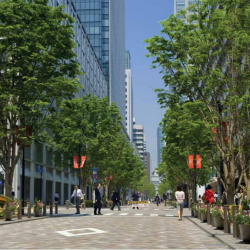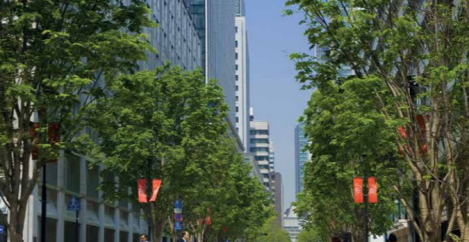March 15, 2022
Retrofit offers the greatest opportunity for a commercial property market beset by uncertainty
 In the context of a second major economic shock from war in Ukraine and continuing inflationary concerns, the PWC / ULI report Emerging Trends in Real Estate Global Outlook 2022 focuses on the global outlook for the real estate industry increasing pressure for finance to support the decarbonisation of real estate. The industry challenges lenders and their regulators to provide debt for the retrofit of existing buildings and the scale-up of the ‘climate tech’ needed.
In the context of a second major economic shock from war in Ukraine and continuing inflationary concerns, the PWC / ULI report Emerging Trends in Real Estate Global Outlook 2022 focuses on the global outlook for the real estate industry increasing pressure for finance to support the decarbonisation of real estate. The industry challenges lenders and their regulators to provide debt for the retrofit of existing buildings and the scale-up of the ‘climate tech’ needed.
Emerging Trends in Real Estate Global Outlook 2022 is based on the three regional Emerging Trends in Real Estate reports that were launched at the end of 2021 and an additional number of interviews by the Urban Land Institute (ULI) and PwC of global real estate sector leaders’ expectations for the year ahead. The report is a key indicator of sentiment in global real estate and investment and development trends across the globe.
Russia’s invasion of Ukraine takes levels of economic uncertainty even higher and brings expectations of slower global growth and higher, longer-lasting inflation. The note of optimism recorded by ULI and PwC at the end of 2021 is couched in more caution now. The prevailing view in the industry is of moderating economic growth, inflation peaking coming out higher for a longer period and longer lasting supply chain issues.
Even before news of the invasion of Ukraine many in the industry were “starting to ratchet back expectations” for 2022 after the record investment of last year. A new wave of apprehension is expected to hit confidence among consumers, occupiers, and investors, resulting in a slowdown in deal making, especially in Europe.
The industry fears it may have to deal with very swift changes in government spending in favour of defence and energy policies and away from the areas that directly benefit real estate, such as infrastructure and housing.
Managing inflation
Inflation, which was one of the major concerns last year, is an even greater concern today as the war in Ukraine intensifies, at least in Europe and the US, with even more uncertainty this year than last.
An elevated level of inflation remains problematic when it comes to development, just at the point when the industry wants to resume pandemic-delayed projects or advance repurposing initiatives. Construction material and labour costs are among the most keenly felt risks for the industry in 2022. Even in Asia Pacific inflation adds to the development challenge, especially related to logistics.
Sector prospects
Most interviewees still cling to the traditional view of real estate as a good inflation hedge, but they are much more cautious about the risk. This may profit demand for operational real estate sectors because many are contra cyclical and more of an inflation hedge than mainstream sectors thanks to the ability to add services and adjust the pricing of these.
Some investors are thinking more about diversification — spreading risk across sectors and geographies, which may well see already strong capital flows from the West to Asia Pacific gather further momentum.
Logistics remains the main draw for investors, although investment volumes will likely fall in logistics along with the rest of real estate. The challenge for investors lies in balancing what looks like late-cycle pricing with the societal, or non-cyclical, shift to e-commerce.
[perfectpullquote align=”right” bordertop=”false” cite=”” link=”” color=”” class=”” size=””]More capital was deployed in apartments than offices globally for the first time in 2021[/perfectpullquote]
The office sector in Asia is not facing the same existential crisis from remote working as in Western markets. By contrast, office deals last year accounted for less than 20 percent of the total invested in US real estate for the first time – a startling decline. Two years on from the outbreak of COVID-19 there is still no clear direction in Europe and the Americas. But in any conceivable outcome, companies will be leasing less space in the future. New hires and added space required for social distancing are unlikely to fill the resulting vacancies.
More capital was deployed in apartments than offices globally for the first time in 2021. This growing attraction of residential has been reflected in Emerging Trends’ North American and European editions over several years. Investor interest in the residential sector continues unabated in 2022, but so do concerns over affordability. Interviewees suggest the same supply-demand dynamics that have led to the housing affordability issue are, in turn, creating a compelling resiliency from a capital markets perspective. The likes of senior living, student housing and co-living, for instance, benefit from lower vacancies and attractive risk-adjusted returns compared to commercial assets.
There is another important aspect to the shift of capital into residential, which lies at the social/affordable end of the spectrum, and once more this trend is more prevalent in North America and Europe than Asia Pacific. Investing in social housing is increasingly seen by investors as an opportunity to combine a stable income with the “S” in ESG. In other words, this represents a smart strategy in both the short and long term.
Repurposing initiatives have been gathering pace over the past year, but the likelihood is that the momentum here will stall as part of the greater market uncertainty.
Financing decarbonisation
The latest interviews find even greater urgency than a year ago around ESG and the resulting risk of obsolescence or stranded assets. Increased tenant focus on healthy buildings, their brands and their own sustainability targets is accelerating the obsolescence of older buildings.
[perfectpullquote align=”right” bordertop=”false” cite=”” link=”” color=”” class=”” size=””]A huge reallocation of capital is already underway towards greening real estate, but there is much more to be done[/perfectpullquote]
The report concludes that organisations providing equity and debt have the power to influence the real estate industry’s approach to decarbonisation and social impact. A huge reallocation of capital is already underway towards greening real estate, but there is much more to be done, especially by lenders and regulators if the industry is to meet its targets.
The question of whether environmental sustainability makes business sense, is largely answered. By contrast, the “S” in ESG, social impact, is in its infancy. But the financing of real estate looking to improve society is growing. However, there are still fundamental issues to resolve in finance markets, the world of debt and equity, before that reallocation can start to ensure real estate contributes to solving the problems of the climate crisis.
Equity investors have been leading the charge, largely working to get ahead of impending regulation. In contrast, debt providers, with notable exceptions, seem to be waiting for regulation to come, being reactive rather than proactive in using their influence to help real estate decarbonise. This is an industry where debt plays a huge role in the financial ecosystem. For lenders to hold back from using their influence at this crucial moment of history is a real missed opportunity.
Sometimes financial markets are creating barriers rather than breaking them down; the abundance of liquidity in the global economy offers an historic opportunity to allocate capital to green buildings and projects. But that same liquidity can reduce the urgency to act among lenders and investors. The way real estate defines a green building can misdirect investors and lenders that might want to act in good faith but end up acting in a way that hinders rather than helps wholesale decarbonisation.
Interviewees are split on whether a green loan on an existing asset would typically offer a reduced margin; some do, some do not. In any case, the reduced loan margins sometimes available to borrowers are not the main benefit. At the same time, the brown discount, buildings without much chance of meeting sustainability standards set by tenants, investors, regulators, or a combination of all the above, is seen as very real.
The plethora of standards and regulations is seen by interviewees as a major hindrance. Lack of agreement about the benchmark level of carbon emissions from a building or the measurement of operational and embodied emission hinders the ability of a financier to demand an improvement or set targets.
In addition, another issue hindering the growth of green lending is lack of demand, or at least, lack of product to lend against. If lenders restrict their green lending programmes to existing energy-efficient properties, then they will quickly run out of available buildings to finance; they are not therefore enacting change.
The real estate industry needs to come together to work with regulators at city, national and international levels to harmonise the definition of “zero carbon”, the way in which carbon emissions are measured, how green buildings are classified, the kind of targets regulators and authorities are going to enforce, and what constitutes a green loan.
As most interviewees for the report conclude, in an ideal world, the term green loan would be unnecessary — every loan would be a green loan. But that world is still a long way off.
The future is retrofitting
For investors, existing buildings that need capital expenditure to make them more energy efficient, present the biggest challenge, and the biggest opportunity. Some interviewees argue that there has never been a better moment, while interest rates are low, to spend the money required to decarbonise existing buildings.
There is a growing understanding in real estate of the role embodied carbon plays in the overall carbon emissions of a building — the carbon emitted in the creation and transportation of the materials needed to build it, and during the demolition process. Creating a new super-green building is almost never the greenest option because of the carbon emitted demolishing what was there previously and creating the new building.
Most interviewees believe that lenders, particularly banks, are a step behind in funding the refurbishment and improvement of existing stock. It is often debt funds that provide finance for value-add refurbishment schemes. Unlike many banks, these unregulated funds are seen as less likely to have a defined sustainability strategy or framework. But by funding such refurbishments, they are playing their part in the green transition, even if the debt provided is not designated a “green loan”. Also, many lenders will provide “green development finance” to projects that will have a high energy efficiency rating when they are complete, without factoring in the embodied carbon created by a project. In that sense, they are providing finance for a project that is creating a significant amount of carbon but still considered “green”.
Value-add and opportunistic investors with short term horizons could emerge as potential champions of retrofit, even though they are unregulated and less likely to have a defined sustainability strategy. Their approach of “buy it, fix it, sell it” is now likely to include making the building as sustainable as possible.














